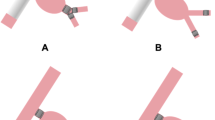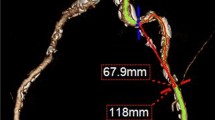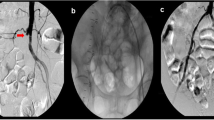Abstract
The aim of this study was to report technical details, procedure-related complications, and results of endovascular treatment in chronic iliac artery occlusion. Between 2001 and 2008, endovascular treatments of 127 chronic iliac artery occlusions in 118 patients (8 women and 110 men; mean age, 59 years) were retrospectively reviewed. The study was based on Ad Hoc Committee on Reporting Standards (Society for Vascular Surgery/International Society for Cardiovascular Surgery Standards). All occlusions were treated with stent placement with or without preliminary balloon angioplasty. Kaplan–Meier estimators were used to determine patency rates. Univariate and multivariate analyses were performed to determine variables affecting successful recanalization, major complications, early stent thrombosis (≤30 days), and primary and secondary patency rates. Initial technical success was achieved in 117 (92%) procedures. Successful recanalization was obtained by antegrade approach in 69 of 77 (90%) procedures and by retrograde approach in 52 of 105 (50%) procedures (p < 0.001). Complications were encountered in 28 (24%) patients [minor in 7 patients (6%) and major in 22 patients (19%)]. One death occurred in the operative period secondary to iliac artery rupture. Early stent thrombosis was seen in eight (7%) patients. Presence of critical limb ischemia (p = 0.03), subintimal recanalization (p = 0.03), and major complication (p = 0.02) were the independent predictors of early stent thrombosis on multivariate analysis. Primary and secondary patency rates at 5 years were 63 and 93%, respectively. Presence of critical limb ischemia, TASC type C iliac lesions, combined occlusions of both common and external iliac arteries, and major complications were associated with decreased patency rates on univariate analysis, whereas these factors were not independent predictors of stent patency on multivariate analysis. In conclusion, endovascular treatment of iliac artery occlusion has a high technical success rate with favorable long-term patency rate. Success of recanalization increases with use of the antegrade approach and with the presence of a stump of artery before the occlusion.


Similar content being viewed by others
References
Norgren L, Hiatt WR, Dormandy JA, on behalf of the TASC II Working Group (2007) Inter-society consensus for the management of peripheral arterial disease (TASC II). Eur J Vasc Endovasc Surg 33(Suppl 1):S1–S75
Henry M, Amor M, Ethevenot G et al (1998) Percutaneous endoluminal treatment of iliac occlusions: long-term follow-up in 105 patients. J Endovasc Surg 5(3):228–235
Gandini R, Fabiano S, Chiocchi M, Chiappa R, Simonetti G (2008) Percutaneous treatment in iliac artery occlusion: long-term results. Cardiovasc Interv Radiol 31(6):1069–1076
Funovics MA, Lackner B, Cejna M et al (2002) Predictors of long-term results after treatment of iliac artery obliteration by transluminal angioplasty and stent deployment. Cardiovasc Interv Radiol 25(5):397–402
Sacks D, Marinelli DL, Martin LG, Spies JB, Society of Interventional Radiology Technology Assessment Committee (2003) Reporting standards for clinical evaluation of new peripheral arterial revascularization devices. J Vasc Interv Radiol 14(9; Pt 2):S395–S404
Rutherford RB, Baker JD, Ernst C et al (1997) Recommended standards for reports dealing with lower extremity ischemia: revised version. J Vasc Surg 26(3):517–538
Ozkan U, Oguzkurt L, Tercan F, Gumus B (2009) Endovascular treatment strategies in aortoiliac occlusion. Cardiovasc Interv Radiol 32(3):417–421
Carnevale FC, De Blas M, Merino S, Egaña JM, Caldas JG (2004) Percutaneous endovascular treatment of chronic iliac artery occlusion. Cardiovasc Interv Radiol 27(5):447–452
Uher P, Nyman U, Lindh M, Lindblad B, Ivancev K (2002) Long-term results of stenting for chronic iliac artery occlusion. J Endovasc Ther 9(1):67–75
Colapinto RF, Stronell RD, Johnston WK (1986) Transluminal angioplasty of complete iliac obstructions. AJR Am J Roentgenol 146(4):859–862
Leville CD, Kashyap VS, Clair DG et al (2006) Endovascular management of iliac artery occlusions: extending treatment to TransAtlantic Inter-Society Consensus class C and D patients. J Vasc Surg 43(1):32–39
Kim JK, Kim YH, Chung SY, Kang HK (1999) Primary stent placement for recanalization of iliac artery occlusions: using a self-expanding spiral stent. Cardiovasc Interv Radiol 22(4):278–281
Bolia A, Fishwick G (1997) Recanalization of iliac artery occlusion by subintimal dissection using the ipsilateral and the contralateral approach. Clin Radiol 52(9):684–687
Ramjas G, Thurley P, Habib S (2008) The use of a re-entry catheter in recanalization of chronic inflow occlusions of the common iliac artery. Cardiovasc Interv Radiol 31(3):650–654
Park KB, Do YS, Kim JH et al (2005) Stent placement for chronic iliac arterial occlusive disease: the results of 10 years experience in a single institution. Korean J Radiol 6(4):256–266
Wiesinger B, Beregi JP, Oliva VL et al (2005) PTFE-covered self-expanding nitinol stents for the treatment of severe iliac and femoral artery stenoses and occlusions: final results from a prospective study. J Endovasc Ther 12(2):240–246
Vorwerk D, Guenther RW, Schürmann K, Wendt G, Peters I (1995) Primary stent placement for chronic iliac artery occlusions: follow-up results in 103 patients. Radiology 194(3):745–749
Author information
Authors and Affiliations
Corresponding author
Rights and permissions
About this article
Cite this article
Ozkan, U., Oguzkurt, L. & Tercan, F. Technique, Complication, and Long-Term Outcome for Endovascular Treatment of Iliac Artery Occlusion. Cardiovasc Intervent Radiol 33, 18–24 (2010). https://doi.org/10.1007/s00270-009-9691-7
Received:
Revised:
Accepted:
Published:
Issue Date:
DOI: https://doi.org/10.1007/s00270-009-9691-7




